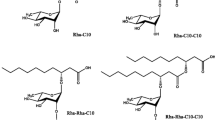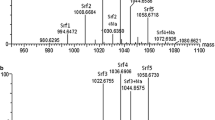Abstract
Biosurfactants have been investigated as potential alternatives for synthetic surfactants in several areas, for example, in environmental and pharmaceutical fields. In that regard, extensive research has been carried out with sophorolipids and rhamnolipids that also present various biological properties with therapeutic significance. These biosurfactants are obtained as complex mixtures of slightly different molecules, and thus when studying these microbial glycolipids, the ability to identify and purify the produced compounds is of extreme importance. This study aimed to develop improved methodologies for the identification, separation, and purification of sophorolipids and rhamnolipids. Therefore, an ultra-high-performance liquid chromatography–tandem mass spectrometry (UHPLC-MS/MS) method was modified to ensure faster characterization of both sophorolipids and rhamnolipids, enabling the identification and fragmentation pattern description of 10 and 13 congeners, respectively. The separation and purification of these biosurfactants was achieved with novel reversed-phase solid-phase extraction methods guaranteeing the isolation of different glycolipids, including those considered for their significant biological activity (e.g. antimicrobial, anticancer). It was possible to isolate sophorolipids and rhamnolipids with purity of 94% and 99%, respectively. The methods presented herein can be easily implemented and are expected to make purification of these biosurfactants easier, facilitating the study of their individual properties in further works.
Graphical abstract







Similar content being viewed by others
References
Ribeiro IAC, Faustino CMC, Guerreiro PS, Frade RFM, Bronze MR, Castro MF, et al. Development of novel sophorolipids with improved cytotoxic activity toward MDA-MB-231 breast cancer cells. J Mol Recognit. 2015;28:155–65. https://doi.org/10.1002/jmr.2403.
Pontes C, Alves M, Santos C, Ribeiro MH, Gonçalves L, Bettencourt AF, et al. Can Sophorolipids prevent biofilm formation on silicone catheter tubes? Int J Pharm. 2016;513:697–708. https://doi.org/10.1016/j.ijpharm.2016.09.074.
Liu Z, Tian X, Chen Y, Lin Y, Mohsin A, Chu J. Efficient sophorolipids production via a novel in situ separation technology by Starmerella bombicola. Process Biochem. 2018;81:1–10. https://doi.org/10.1016/j.procbio.2018.12.005.
Bettencourt AF, Tomé C, Oliveira T, Martin V, Santos C, Gonçalves L, et al. Exploring the potential of chitosan-based particles as delivery-carriers for promising antimicrobial glycolipid biosurfactants. Carbohydr Polym. 2021;254:117433. https://doi.org/10.1016/j.carbpol.2020.117433.
Drakontis CE, Amin S. Biosurfactants: formulations, properties, and applications. Curr Opin Colloid Interface Sci. 2020;48:77–90. https://doi.org/10.1016/j.cocis.2020.03.013.
Pathania AS, Jana AK. Improvement in production of Rhamnolipids using fried oil with hydrophilic co-substrate by indigenous Pseudomonas aeruginosa NJ2 and characterizations. Appl Biochem Biotechnol. 2020;191:1223–46. https://doi.org/10.1007/s12010-019-03221-9.
Tanga J, Heb J, Tanga H, Wang H, Sima W, Liang C, et al. Heavy metal removal effectiveness, flow direction and speciation variations in the sludge during the biosurfactant-enhanced electrokinetic remediation. Sep Purif Technol. 2020;246:116918. https://doi.org/10.1016/j.seppur.2020.116918.
Díaz De Rienzo MA, Banat IM, Dolman B, Winterburn J, Martin PJ. Sophorolipid biosurfactants: possible uses as antibacterial and antibiofilm agent. New Biotechnol. 2015;32:720–6. https://doi.org/10.1016/j.nbt.2015.02.009.
Jiang J, Zu Y, Li X, Meng Q, Long X. Recent progress towards industrial rhamnolipids fermentation: process optimization and foam control. Bioresour Technol. 2020;298:122394. https://doi.org/10.1016/j.biortech.2019.122394.
Chen Y, Tian X, Li Q, Li Y, Chu J, Hang H, et al. Target-site directed rational high-throughput screening system for high sophorolipids production by Candida bombicola. Bioresour Technol. 2020;315:123856. https://doi.org/10.1016/j.biortech.2020.123856.
Elshikh M, Funston S, Chebbi A, Ahmed S, Marchant R, Banat IM. Rhamnolipids from non-pathogenic Burkholderia thailandensis E264: physicochemical characterization, antimicrobial and antibiofilm efficacy against oral hygiene related pathogens. New Biotechnol. 2017;36:26–36. https://doi.org/10.1016/j.nbt.2016.12.009.
Chebbi A, Elshikh M, Haque F, Ahmed S, Dobbin S, Marchant R, et al. Rhamnolipids from Pseudomonas aeruginosa strain W10; as antibiofilm/antibiofouling products for metal protection. J Basic Microbiol. 2017;57:364–75. https://doi.org/10.1002/jobm.201600658.
Abdel-Mawgoud AM, Lépine F, Déziel E. Rhamnolipids: diversity of structures, microbial origins and roles. Appl Microbiol Biotechnol. 2010;86:1323–36. https://doi.org/10.1007/s00253-010-2498-2.
Marchant R, Banat IM. Biosurfactants: a sustainable replacement for chemical surfactants? Biotechnol Lett. 2012;34:1597–605. https://doi.org/10.1007/s10529-012-0956-x.
Jie Z, Xue R, Liu S, Xu N, Xin F, Zhang W, et al. High Di-rhamnolipid production using Pseudomonas aeruginosa KT1115, separation of mono/Di-rhamnolipids, and evaluation of their properties. Front Bioeng Biotechnol. 2019;7:1–9. https://doi.org/10.3389/fbioe.2019.00245.
Heyd M, Kohnert A, Tan TH, Nusser M, Kirschhöfer F, Brenner-Weiss G. Franzreb M, Berensmeier S. Development and trends of biosurfactant analysis and purification using rhamnolipids as an example. Anal Bioanal Chem 2008;391:1579–1590. https://doi.org/10.1007/s00216-007-1828-4.
Ribeiro IA, Castro MF BMR, MHL R. Design of selective production of sophorolipids by Rhodotorula bogoriensis through nutritional requirements. J Mol Recog. 2012;25:630–40. https://doi.org/10.1002/jmr.2188.
George S, Jayachandran K. Production and characterization of rhamnolipid biosurfactant from waste frying coconut oil using a novel Pseudomonas aeruginosa D. J Appl Microbiol. 2013;114:373–83. https://doi.org/10.1111/jam.12069.
Sen S, Borah SN, Bora A, Deka S. Production, characterization, and antifungal activity of a biosurfactant produced by Rhodotorula babjevae YS3. Microb Cell Factories. 2017;16:1–14. https://doi.org/10.1186/s12934-017-0711-z.
Ribeiro IA, Bronze MR, Castro MF, Ribeiro MHL. Optimization and correlation of HPLC-ELSD and HPLC-MS/MS methods for identification and characterization of sophorolipids. J Chromatogr B Anal Technol Biomed Life Sci. 2012;899:72–80. https://doi.org/10.1016/j.jchromb.2012.04.037.
Behrens B, Engelen J, Tiso T, Blank LM, Hayen H. Characterization of rhamnolipids by liquid chromatography/mass spectrometry after solid-phase extraction. Anal Bioanal Chem. 2016;408:2505–14. https://doi.org/10.1007/s00216-016-9353-y.
Mohammed ABA, Tayel AA, Elguindy NM. Production of new rhamnolipids Rha C16-C16 by Burkholderia sp. through biodegradation of diesel and biodiesel. Beni-Suef. Univ J Basic Appl Sci. 2018;7:492–8. https://doi.org/10.1016/j.bjbas.2018.05.003.
Zhao F, Jiang H, Sun H, Liu C, Han S, Zhang Y. Production of rhamnolipids with different proportions of mono-rhamnolipids using crude glycerol and a comparison of their application potential for oil recovery from oily sludge. RSC Adv. 2019;9:2885–91. https://doi.org/10.1039/c8ra09351b.
Jadhav J, Dutta S, Kale S, Pratap A. Fermentative production of rhamnolipid and purification by adsorption chromatography. Prep Biochem Biotechnol. 2018;48:234–41. https://doi.org/10.1080/10826068.2017.1421967.
Rudden M, Tsauosi K, Marchant R, Banat IM, Smyth TJ. Development and validation of an ultra-performance liquid chromatography tandem mass spectrometry (UHPLC-MS/MS) method for the quantitative determination of rhamnolipid congeners. Appl Microbiol Biotechnol. 2015;99:9177–87. https://doi.org/10.1007/s00253-015-6837-1.
Shao L, Song X, Ma X, Li H, Qu Y. Bioactivities of sophorolipid with different structures against human esophageal cancer cells. J Surg Res. 2010;173(2):286–91. https://doi.org/10.1016/j.jss.2010.09.013.
Ribeiro IAC, Bronze MR, Castro MF, Ribeiro MHL. Selective recovery of acidic and lactonic sophorolipids from culture broths towards the improvement of their therapeutic potential. Bioprocess Biosyst Eng. 2016;39:1825–183. https://doi.org/10.1007/s00449-016-1657-y.
Maeng Y, Kim KT, Zhou X, Jin L, Kim KS, Kim YM, et al. A novel microbial technique for producing high-quality sophorolipids from horse oil suitable for cosmetic applications. Microb Biotechnol. 2018;11:917–29. https://doi.org/10.1111/1751-7915.13297.
Tang Y, Ma Q, Du Y, Ren L, Zyl LJV, Long X. Efficient purification of sophorolipids via chemical modifications coupled with extractions and their potential applications as antibacterial agents. Sep Purif Technol. 2020;245:116897. https://doi.org/10.1016/j.seppur.2020.116897.
Jadhav JV, Pratap AP, Kale SB. Evaluation of sunflower oil refinery waste as feedstock for production of sophorolipid. Process Biochem. 2019;78:15–24. https://doi.org/10.1016/j.procbio.2019.01.015.
Joshi-Navare K, Khanvilkar P, Prabhune A. Jatropha oil derived sophorolipids: production and characterization as laundry detergent additive. Biochem Res Int. 2013;2013:1–11. https://doi.org/10.1155/2013/169797.
Amani H. Study of enhanced oil recovery by rhamnolipids in a homogeneous 2D micromodel. J Pet Sci Eng. 2015;128:212–9. https://doi.org/10.1016/j.petrol.2015.02.030.
Déziel E, Lépine F, Milot S, Villemur R. Mass spectrometry monitoring of rhamnolipids from a growing culture of Pseudomonas aeruginosa strain 57RP. Biochim Biophys Acta - Mol Cell Biol Lipids. 2000;1485:145–52. https://doi.org/10.1016/S1388-1981(00)00039-1.
Sharma A, Jansen R, Nimtz M, Johri BN, Wray V. Rhamnolipids from the rhizosphere bacterium Pseudomonas sp. GRP3 that reduces damping-off disease in chilli and tomato nurseries. J Nat Prod. 2007;70:941–7. https://doi.org/10.1021/np0700016.
Nitschke M, Costa SGVAO, Contiero J. Structure and applications of a rhamnolipid surfactant produced in soybean oil waste. Appl Biochem Biotechnol. 2010;160:2066–74. https://doi.org/10.1007/s12010-009-8707-8.
George S, Jayachandran K. Analysis of Rhamnolipid biosurfactants produced through submerged fermentation using Orange fruit peelings as sole carbon source. Appl Biochem Biotechnol. 2009;158:694–705. https://doi.org/10.1007/s12010-008-8337-6.
Borsanyiova M, Patil, Mukherji AR, Prabhune A, Bopegamage S. Biological activity of sophorolipids and their possible use as antiviral agents. Folia Microbiol. 2016;61:85–9. https://doi.org/10.1007/s12223-015-0413-z.
Aleksic I, Petkovic M, Jovanovic M, Milivojevic D, Vasiljevic B, Nikodinovic-Runic J, et al. Anti-biofilm properties of bacterial di-rhamnolipids and their semi-synthetic amide derivatives. Front Microbiol. 2017;8:1–16. https://doi.org/10.3389/fmicb.2017.02454.
Chen J, Wu Q, Hua Y, Chen J, Zhang H, Wang H. Potential applications of biosurfactant rhamnolipids in agriculture and biomedicine. Appl Microbiol Biotechnol. 2017;101:8309–19. https://doi.org/10.1007/s00253-017-8554-4.
Elshikh M, Moya-Ramírez I, Moens H, Roelants S, Soetaert W, Marchant R, et al. Rhamnolipids and lactonic sophorolipids: natural antimicrobial surfactants for oral hygiene. J Appl Microbiol. 2017;123:1111–23. https://doi.org/10.1111/jam.13550.
Kristoffersen V, Rämä T, Isaksson J, Andersen JH, Gerwick WH, Hansen E. Characterization of Rhamnolipids produced by an Arctic marine bacterium from the Pseudomonas fluorescence group. Mar Drugs. 2018;16(5):163. https://doi.org/10.3390/md16050163.
Acknowledgements
The authors thank Fundação para a Ciência e Tecnologia (FCT) for the financial support under Project PTDC/BTM-SAL/29335/2017, UIDB/04138/2020 and UIDP/04138/2020 (iMed.ULisboa). The authors would also like to acknowledge the financial support from Fundação para a Ciência e Tecnologia (FCT) and Portugal 2020 to the Portuguese Mass Spectrometry Network (Rede Nacional de Espectrometria de Massa RNEM; LISBOA 01 0145 FEDER 402 022125). The authors also acknowledge the Designer Nuno Monge for the artwork and Andreia Bento for the assistance with the UHPLC-MS/MS equipment.
Author information
Authors and Affiliations
Corresponding author
Ethics declarations
Conflict of interest
The authors declare that they have no conflict of interest.
Additional information
Publisher’s note
Springer Nature remains neutral with regard to jurisdictional claims in published maps and institutional affiliations.
Rights and permissions
About this article
Cite this article
Dardouri, M., Mendes, R.M., Frenzel, J. et al. Seeking faster, alternative methods for glycolipid biosurfactant characterization and purification. Anal Bioanal Chem 413, 4311–4320 (2021). https://doi.org/10.1007/s00216-021-03387-4
Received:
Revised:
Accepted:
Published:
Issue Date:
DOI: https://doi.org/10.1007/s00216-021-03387-4




